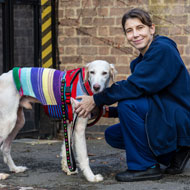Technology can distinguish between playfulness and aggression.
Researchers from the University of Michigan are exploring how artificial intelligence (AI) could be used to decipher dog barks.
The AI model has the potential to discover information from animal vocalisations, including the dog’s age, breed and sex. The researchers also believe it could identify if a bark is playful or aggressive.
The project saw researchers adapt a speech-processing model, which was previously trained to study human speech.
Through a collaboration with the National Institute of Astrophysics, Optics and Electronics (INAOE) Institute in Mexico, the team discovered that this model could act as a starting point for training new systems for animal communication.
The development of an AI model for animal vocalisations was previously hampered by the lack of public data. Although human samples are easy to record, there are more limitations when collecting animal recordings.
Researchers say that animal vocalisations are logistically more difficult to record as they either need to be recorded in the wild or, for domestic pets, with the permission of owners.
It was due to these limitations that researchers opted to instead repurpose an existing, human-oriented model.
Existing voice technologies, such as voice-to-text and language translation, are trained to identify the nuances of human speech. The tools are able to distinguish between tone, pitch and accent to translate speech and identify speakers.
The team adapted this model by using a dataset of dog vocalisations from 74 different dogs – of varying breed, age, sex and context. These recordings were then used to modify the machine-learning model.
Using this tool, researchers were able to generate and interpret acoustic representations from the dogs. The AI model not only passed four different classification tasks, but also outperformed other models specifically trained on dog barks with accuracy figures of up to 70 per cent.
Rada Mihalcea, from the University of Michigan’s AI laboratory, said: "This is the first time that techniques optimised for human speech have been built upon to help with the decoding of animal communication.
"Our results show that the sounds and patterns derived from human speech can serve as a foundation for analysing and understanding the acoustic patterns of other sounds, such as animal vocalisations."
The full study can be found here.
Image © Shutterstock






 The BSAVA has opened submissions for the BSAVA Clinical Research Abstracts 2026.
The BSAVA has opened submissions for the BSAVA Clinical Research Abstracts 2026.
